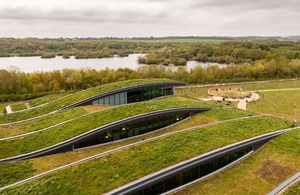New drainage standards tackle pollution in England鈥檚 communities聽
Developers encouraged to reduce pollution, protect communities from flooding and benefit nature as part of government鈥檚 ambition to build 1.5 million homes.聽

extensive wildflower green roof
In a move to tackle water pollution and protect communities from flooding, the government is updating the national standards for Sustainable Drainage Systems (SuDS) for the first time in a decade.聽聽
The new standards 鈥� welcomed by the construction industry - will give developers clearer guidance on how to create rainwater management systems that mimic the natural environment聽and deliver better outcomes.
Suggested features include spaces designed to collect and filter rainwater, which will relieve pressure on our crumbling sewage system and prevent pollution overflowing into our waterways.聽
Impermeable surfaces such as roads and pavements increase the risk of flooding in heavy downpours, as the excess water has nowhere to go. By introducing materials designed to soak up water, new developments will be better protected against flooding.聽
The new standards will also encourage design features like green roofs and soakaways. These provide a place for nature to thrive and improve a building鈥檚 energy efficiency 鈥搑educing energy bills, bringing mental and physical health benefits to communities by expanding access to nature and supporting wildlife.聽
The updated standards signify the government鈥檚 ambition to build 1.5 million homes sustainably without delaying the planning process聽and comes following the record 拢104 billion secured from private sector investment to clean up our rivers, lakes and seas.聽
Water Minister Emma Hardy said:聽
The Government will introduce new standards to tackle water pollution, protect communities from flooding and make our new towns beautiful.聽
Nature recovery and growth can go hand in hand, and these new standards will enable the sustainable building of 1.5 million homes as part of the Plan for Change.聽
Key features of the new standards include:聽
- Reducing flood聽risk聽by actively managing surface water on site
- Improving water quality聽before it enters rivers and streams
- Provide聽community benefits聽by creating more attractive and resilient places to live and work聽
- Prioritising solutions that聽enhance biodiversity聽and green space
- Encouraging water efficiency, by enabling the聽reuse of rainwater聽through harvesting and collection systems
- Emphasising聽long-term maintenance聽and performance聽
To support the government鈥檚 Plan for Change, the updated standards are aligned with the National Planning Policy Framework and will聽complement wider planning reforms which will take place later this year.聽Developers are encouraged to innovate and demonstrate how their systems meet the outcomes, rather than follow a one-size-fits-all checklist.聽